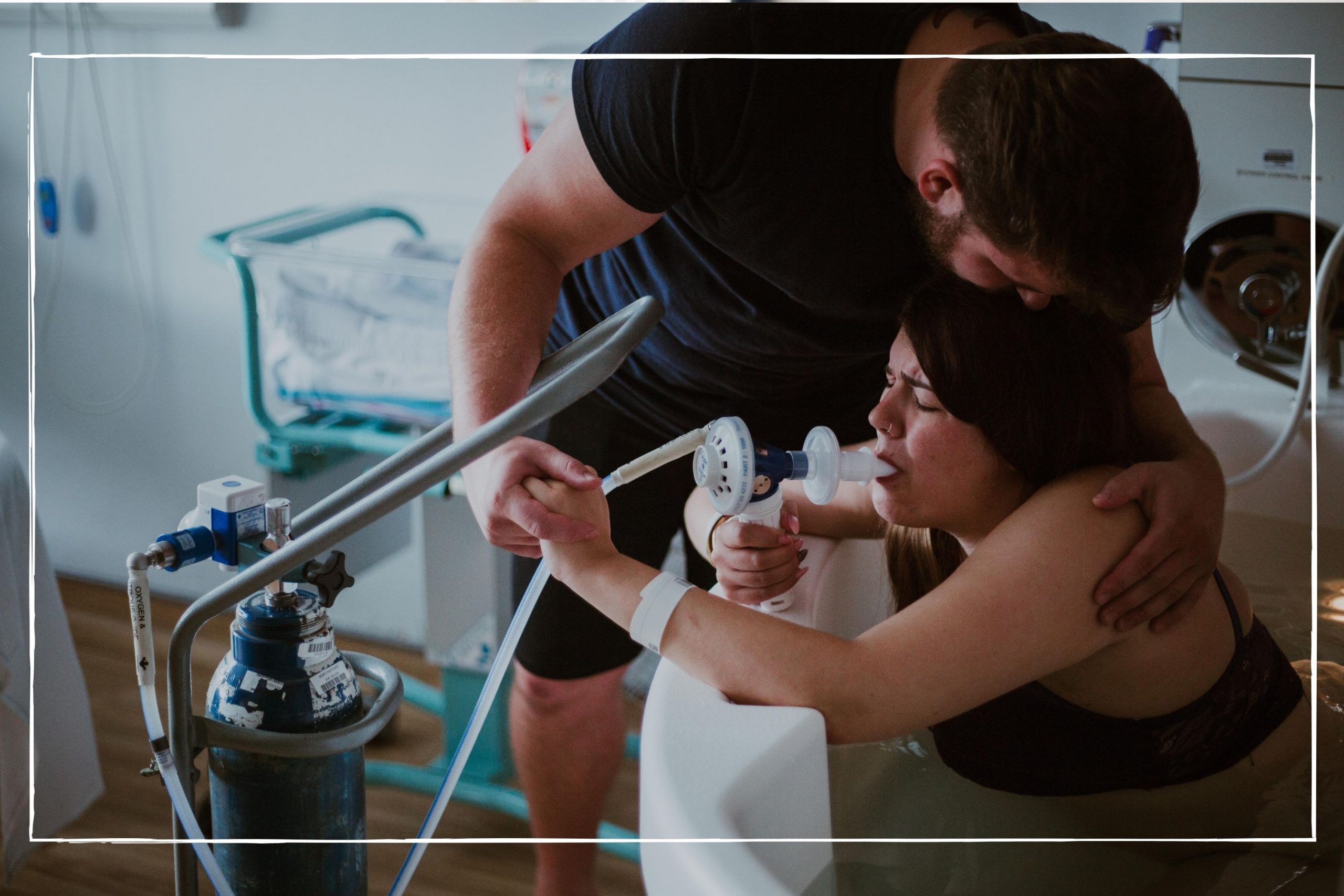Gas and air in labour: when it's used, side effects, pros and cons


Gas and air - also known as Entonox - is a medical gas, commonly used for pain relief in labour. Breathed in using a mouthpiece, it gives relief within just a few seconds and only lasts for the duration of each contraction.
Gas and air can be used in all birth locations: at home births, at midwife-led units and in hospitals. Although it can make you feel nauseous or giggly, it has relatively few side effects, which makes it a popular choice for labouring mums.
Consultant Obstetric Anaesthetist, Dr Simon Jones told us, "Gas and air is a really common option for UK mums and it's safe and easily available wherever you give birth. It's most effective when you have a good technique, timing breathing with contractions. Some mums get through their whole labour with gas and air whereas other women use it with other medication, too"
When do you use gas and air in labour?
Gas and air can be used as often as you like once you've been admitted in labour. It's used to relieve the pain of contractions, so is most useful when they come on - rather than in between each contraction. Hospitals have it supplied to most labouring rooms, through a wall port. If you are giving birth at home or in a midwife-led unit, you will use a mouthpiece attached to a metal canister.
Entonox is composed of 50 per cent oxygen and 50 per cent nitrous oxide - also known as laughing gas. As it can be prescribed by a midwife, it's available for use at whichever location you choose to birth (home, midwife-led unit, or hospital?).
Studies show it works similarly to other painkillers, which stop pain receptors in the brain from working. It's rated very highly by labouring mums and 77 per cent of mums use it, according to research by the UK's Care Quality Commission (CQC).
Dr Jones, Consultant Obstetric Anaesthetist, told us, "Gas and air is a very effective pain reliever in labour. A lot of labouring mums, like gas and air because it makes them feel in control of the pain. The pain-relieving effects kick in seconds after you breathe it in, so you can time it just right, as a contraction begins. "
Parenting advice, hot topics, best buys and family finance tips delivered straight to your inbox.
Side effects of gas and air
- Nausea
- A feeling of being high (euphoria)
- Dizziness
- Dry mouth
- Sleepiness
Source: British National Formulary, National Insitute Clinical Excellence (UK).
Most side effects are temporary and will go away quickly after you stop breathing it in. Commonly used in early labour, it can also be used with other labour pain relief options, like pethidine, and before having an epidural - a highly effective, spinal pain relief for labour.
Gas and air does not affect your baby. Because gas and air is breathed in, it goes straight to the pain-relieving receptors in your brain. Studies show that there are no appreciable effects on babies at birth from using gas and air in labour.
How long does gas and air take to wear off?
Within 30 seconds after breathing in Entonox, there is a fall of about 35 per cent of the drug in your body as you breathe it out, as verified by the manufacturer.
Most people feel completely normal within about 5 minutes of stopping Entonox, according to a study by Zacny et. al.
Is gas and air better than an epidural?
Weighing up the use of Entonox versus an epidural isn't a simple question: it depends on your point of view. It's important to remember that you can have an epidural and use gas and air together. Some women go through their entire labour using gas and air, whereas others later choose to have an epidural.
Gas and air is most commonly used in the first stages of early labour.
Only a few studies have directly compared epidural with gas and air. When it comes to weighing up pain relief alone, studies in 2018 have shown that epidurals are superior to gas and air for pain relief. This is especially true in the later stages of labour.
However, epidurals have more side effects, which can include:
- headaches (1 in 100 women will have a headache in labour)
- longer labour according to some obstetric anaesthetics advice
Only you can answer the question of whether Entonox is better for you than an epidural, after weighing up the evidence. This is harder to do if you're a first-time mum, with no reference to what labour is like.
You might think you would prefer to have only gas and air. Then, when labour starts, you might find the pain is worse than you expected. It's ok to be flexible in your approach. Remember that your birth plan for pain relief is not set in stone. There's no shame in changing your mind and many women do, once labour begins. Your medical team will always support you in making decisions. Every labour is different. Even if you went through previous labours without an epidural, you might decide that you want one this time.
Dr Stephen Jones, an expert in anaesthetics for labour says "We don’t judge people for changing their mind - your pain relief choices don’t have to be absolutely fixed in place. It’s always worth finding out the pros and cons of each option. However, if you would like an epidural, it's usually easier to do when you're in the earlier stages of labour. If you think you do want an epidural, discuss it with your midwife sooner rather than later."
Gas and air pros and cons
Pros
- the effects do not last very long (a few seconds or minutes)
- Some mums say gas and air gives them a sense of control over their pain
- You can stop taking it when you want to
- It does not affect the length of labour
- It has no impact on your baby
- Mums say it's very effective and quick pain relief
- Use gas and air at home, at a midwife unit or in a hospital
Cons
- Entonox can make some women feel sick
- Repeated use can make your mouth feel dry
- Nitrous oxide impacts the environment, according to climate research on the ozone layer it "will remain in the atmosphere for more than 100 years.”
Related video: Old wives' tales for predicting the sex of your baby

Tannice Hemming has worked alongside her local NHS in Kent and Medway since she became a parent and is now a mum of three. As a Maternity Voices Partnership Chair, she bridged the gap between service users (birthing women and people, plus their families) and clinicians, to co-produce improvements in Maternity care. She has also worked as a breastfeeding peer supporter. After founding the Keep Kent Breastfeeding campaign, she regularly appears on KMTV, giving her views and advice on subjects as varied as vaccinations, infant feeding and current affairs affecting families. Two of her proudest achievements include Co-authoring Health Education England’s E-learning on Trauma Informed Care and the Kent and Medway Bump, Birth and Beyond maternity website.